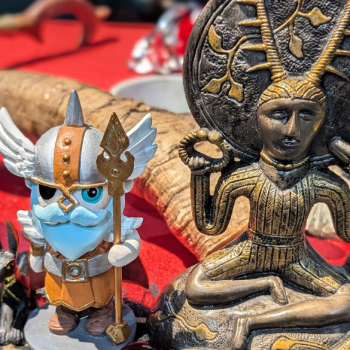“I love finding out about discourse when I’ve already made a strong decision. My profile picture is my altar.” –Davo Deth
I was once conscripted to help run a private ritual, and afterwards, one of the participants came up to me with questions.
“When you were setting up the altar, I couldn’t help noticing that you put your knife in a specific place, in a very deliberate way,” he said. “And that made me wonder: What was the symbolism behind that? What was the deeper meaning?”
And in response, I was like, “I… I put it there so that I could reach it.”
It was probably not the answer he wanted, alas, but it was the only one I had to give.

The memory of that conversation came back to me last week, while I was munching on salty snacks and leisurely scrolling through the latest WitchTok imbroglio. Apparently, someone had uploaded a video that included images of their altar, which prompted a veritable platoon of online occultists to descend with videos of their own that were all, “Nooooo!!! If you post a picture of your altar, people can use it to curse you.”
Less hypochondriac voices quickly entered the fray, reasoning that a) if your immediate environment is adequately warded, no one could use a picture of your altar to direct a curse into it, and b) the likelihood of anyone truly attempting to curse anyone else through an altar pic is slim to none. Unfortunately, the doomsayers doubled down, inventing all kinds of creative rationalizations regarding protective magic and its ultimate impotence in the face of baneful sorcery.
Unless, of course, the protective magic itself is the baneful sorcery. In the latest hot take that (as always) I promise I am not making up, putting wards on yourself or your home is probably causing your friends and family to come down with serious illnesses.
I can only assume that by next week, altars in general will be declared closed practices.
Currently, I do not have the spoons to process the whole Deadly Protection debate (although Deadly Protection would be an amazing name for a series on Investigation Discovery). Instead, let’s take another look at curses, how they work, and whether or not a picture of an altar would make for an effective target. (Spoiler: It would not.)

In its most recognizable form, a curse is a type of sympathetic magic. A representation of a given victim is created/obtained to act as a link to the victim themself, and whatever happens to the representation will happen to the victim.
Examples of representations, ranked from least to greatest efficacy, include:
- The victim’s full name.
- A photograph of the victim (rendered less useful by filters and touch-up apps — online images of people tend to depict how they want other to believe how they appear versus how they actually appear in person, which reduces the connective potential of the link).
- An object handled by the victim.
- An article of clothing worn by the victim.
- A personal concern of the victim (hair, nail clippings, bodily fluids, etc.)
So if I were going to put a curse on, say, a troublesome co-worker, I might swipe their favorite pen to act as the focus. A photo of the pen, however, wouldn’t provide an effective link — regardless of how often he’s touched the subject of the photo, my co-worker won’t have put his dirty mitts on the photo itself. There simply wouldn’t be any connection there.
Likewise, a picture of someone’s altar doesn’t offer any direct linkage to that person. I mean, theoretically, you could put a curse on the altar itself, but it would probably get diffused by the metaphysical static of any active magical practice occurring there.
Not to mention that if someone is regularly communing with their Gods at their altar, it stands to reason that their Gods have a defined presence there — ergo, any curse thrown at the altar would reach the Gods well before it reached the intended target. And I can’t imagine that ending well for the caster. (Unless we’re going back to the heady days of hexing the Moon, in which case all bets are off.)

Of course, all of the squabbles about altar curses inevitably led to pronouncements on what does or does not constitute a “correct” altar setup, which was less about education and more about a handful of self-titled elders and experts attempting to assert dominance while reinforcing the insecurities of their followers. And in the midst of it, one of my own followers (who’s lovely, by the way) mentioned that she’d caught some flak in the past for arranging her altar “backwards”… because she’s left-handed.
I have had people say similar things about my altar — they actually got pretty worked up about it. But those same people also told me that I was superstitious and irrational for not wanting anyone to handle my ritual tools, so very quickly, I made the formal decision not to listen to those people.
Ultimately, an altar is just a fixture, in front of or around which worship, meditation, or magical work takes place. And despite what anyone may say on the Internet, there is not a right or wrong way to set up an altar — there’s just what right for you. Make your altar a space where you feel comfortable and confident venerating your Gods. If your Gods want you to set it up any differently than you have, I’m pretty sure They will let you know.
Additionally, whether or not you choose to put pictures of your altar online is entirely up to you, although Thorn Mooney said something in a recent video that’s worth keeping in mind:
“I don’t share my working magical space for the same reason I don’t talk about my sex life. It’s not because I’m afraid people are going to hurt me — it’s because it’s nobody’s business. I don’t put my altar on social media for the same reason I don’t put my underwear drawer on social media.”

Thorn also explained why she’s not worried about rogue witches trying to curse her through her altar, so hopefully, her words will put any lingering fears on the subject to rest. But with that out of the way, if you’re at all concerned about your own altar not being “proper,” or not meeting arbitrary influencer standards, let me just say this:
Sight unseen, I’m going to hazard a guess and say that your altar is lovely and perfect the way it is. And anyone who disagrees with me can take their altar and shove it.


















